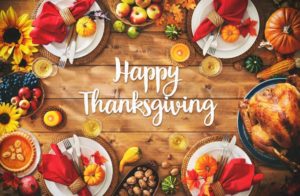Happy Thanksgiving!
Four Hundred years ago in 1621 – one year after the arrival of the Mayflower in Massachusetts, transporting 102 religious separatists from Plymouth, England seeking a new home where they could freely practice their faith and lured by the promise of prosperity and land ownership in the “New World” – an assortment of Plymouth colonists and the Wampanoag shared an autumn harvest feast that is acknowledged today as one of the first Thanksgiving celebrations in the colonies.
After a treacherous and uncomfortable crossing that lasted 66 days, passengers abroad the Mayflower attempted to brave the brutal winter by remaining on board the ship, where they suffered from exposure, scurvy and outbreaks of contagious disease. Only half of the Mayflower’s original passengers and crew lived to see their first New England spring. In March, the remaining settlers moved ashore, where they received a visit from a member of the Abenaki tribe who surprisingly greeted them in English.
Several days later, Abenaki returned with another Native American, Squanto, a member of the Pawtuxet tribe who had been kidnapped by an English sea captain and sold into slavery before escaping to London and returning to his homeland on an exploratory expedition. Squanto taught the Pilgrims, weakened by malnutrition and illness, how to cultivate corn, extract sap from maple trees, catch fish in the rivers and avoid poisonous plants. He also helped the settlers forge an alliance with the Wampanoag, a local tribe.
In November 1621, thanks to the help and direction of Squanto, the Pilgrims’ reaped their first successful harvest of corn. Governor William Bradford organized a celebratory feast and invited a group of the fledgling colony’s Native American allies, including the Wampanoag chief Massasoit. The festival lasted for three days. Pilgrim chronicler Edward Winslow, wrote:
“Our harvest being gotten in, our governor sent four men on fowling, that so we might after a special manner rejoice together, after we had gathered the fruits of our labors; they four in one day killed as much fowl, as with a little help beside, served the Company almost a week, at which time amongst other Recreations, we exercised our Arms, many of the Indians coming amongst us, and amongst the rest their greatest king Massasoit, with some ninety men, whom for three days we entertained and feasted, and they went out and killed five Deer, which they brought to the Plantation and bestowed on our Governor, and upon the Captain and others. And although it be not always so plentiful, as it was at this time with us, yet by the goodness of God, we are so far from want, that we often wish you partakers of our plenty.”
– Edward Winslow
During the American Revolution, the Continental Congress designated one or more days of thanksgiving a year, and in 1789 George Washington issued the first Thanksgiving proclamation by the national government of the United States. His successors John Adams and James Madison also designated days of thanks during their presidencies, with New York becoming the first of several states to officially adopt an annual Thanksgiving holiday.
At the height of the Civil War, President Abraham Lincoln declared a proclamation urging all Americans to ask God to:
“…commend to his tender care all those who have become widows, orphans, mourners or sufferers in the lamentable civil strife” and to “heal the wounds of the nation.”
– Abraham Lincoln
Lincoln scheduled Thanksgiving for the final Thursday in November, and it was celebrated on that day every year until 1939, when Franklin D. Roosevelt moved the holiday up a week in an attempt to spur retail sales during the Great Depression, officially adopting the celebration of Thanksgiving in 1941 to be held on the fourth Thursday in November.
Today, nearly 90 percent of Americans eat the bird—whether roasted, baked or deep-fried—on Thanksgiving, according to the National Turkey Federation. Other traditional foods include stuffing, mashed potatoes, cranberry sauce and pumpkin pie. Volunteering is a common Thanksgiving Day activity, and communities often hold food drives and host free dinners for the less fortunate. Parades have also become a common occurrence in cities and towns across the United States. Since 1924 Macy’s department store has presented, New York City’s Thanksgiving Day parade, which is the largest and most famous parade in the United States, attracting some 2 to 3 million spectators along its 2.5-mile route.
Source: https://www.history.com/topics/thanksgiving/history-of-thanksgiving


